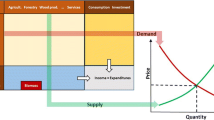Abstract
An issue that arises when considering the potential damages of climate change is whether it is possible to slow or stop human caused climate change. One suggestion to reduce the threat of global warming is to change our management of forests to offset carbon emissions. This study examines the impacts of such a policy on environmental amenities in existing Douglas-fir forests. In this analysis Douglas-fir forest management is modelled in a Faustmann framework, where the forest produces three goods: timber, carbon sequestration and amenities. Using this framework, the level of amenities under profit-maximizing and carbon-sequestration management regimes are compared. The change in the level of seven specific amenities is modelled. These amenities include trout, wildlife diversity, visual aesthetics, soil stability, deer populations, elk populations, and water yield. The study finds that the effect of a carbon sequestration policy will depend on the discount rate chosen. In most situations externalities vary less than plus or minus ten percent. However, those externalities that exhibit discontinuities in their relationship to forest age may vary a hundred percent or more depending on the discount rate used.
Similar content being viewed by others
References
Adams, D., Adams, R., Callaway, J., Chang, C., and McCarl, B.: 1993, ‘The Economics of Sequestering Carbon on Agricultural Land in US: A Preliminary Analysis of Social Cost and Impacts on Timber Markets’,Contemp. Policy Issues 11, 76–87.
Birdsey, R.: 1991a, ‘Prospective Changes in Forest Carbon Storage from Increasing Forest Area and Timber Growth’, U.S. Forest Service, Washington, D.C.
Birdsey, R.: 1991b, ‘Carbon Storage and Accumulation in United States Forest Ecosystems’, U.S. Forest Service, Washington, D.C.
Brazee, R. and Mendelsohn, R.: 1988, ‘A Dynamic Model of Timber Markets’,Forest Sci. 37, 359–372.
Calish, R., Fight, R., and Teegaurden, D.: 1978, ‘How Do Non-timber Values Affect Douglas-Fir Rotations?’,J. Forestry 76, 217–221.
Englin, J.: 1990, ‘Backcountry Hiking and Optimal Timber Rotation’,J. Environm. Managem. 33, 97–105.
Englin, J. and Callaway, J.: 1993, ‘Global Climate Change and Optimal Forest Management’,Natural Resource Model. 7, 191–202.
Englin, J. and Klan, M.: 1990, ‘Optimal Taxation: Timber and Externalities’,J. Environm. Econom. Managem. 21, 263–275.
Gamponia, V. and Mendelsohn, R.: 1987, ‘The Economic Efficiency of Forestry Taxes’,Forest Sci. 33, 367–378.
Hartman, R.: 1976, ‘The Harvesting Decision when a Standing Forest has Value’,Econom. Inquiry 14, 52–58.
Loomis, J.: 1989, ‘A More Complete Accounting of Costs and Benefits from Timber Sales’,J. Forestry 87, 19–23.
McArdle, R.: 1949, ‘The Yield of Douglas-Fir in the Pacific Northwest’,USDA Technic. Bull. #201.
Mills, J.: 1989,Inventory, Growth, and Management Assumptions for the 1989 RPA Timber Assessment: Part II - The North and West, U.S. Forest Service Pacific Northwest Range Station, Portland, Oregon.
Moulton, R. J. and Richards, K. B.: 1990,Cost of Sequestering Carbon through Tree Planting and Forest Management in the U.S., General Technical Report WO-58, U.S.D.A. Forest Service, Washington D.C.
National Academy of Sciences: 1979,Carbon Dioxide and Climate: A Scientific Assessment, National Academy of Sciences, Washington DC.
National Academy of Sciences: 1982,Carbon Dioxide and Climate: A Second Assessment, National Academy Press, Washington DC.
National Academy of Sciences: 1991,Policy Implications of Greenhouse Warming, National Academy Press, Washington DC.
Nordhaus, W.: 1991a, ‘Economic Approaches to Greenhouse Warming’, in Dornbusch, R. and Portuba, J. (eds.),Global Warming: Economic Policy Responses, MIT Press, Cambridge, MA. 1991, pp. 71–97.
Nordhaus, W.: 1991b, ‘The Cost of Slowing Climate Change: A Survey’,Energy J. 12, 37–66.
Nordhaus, W.: 1992, ‘An Optimal Transition Path for Controlling Greenhouse Gases’,Science 258, 1315–1319.
Row, C. and Phelps, R.: 1992, ‘Determining the Flows and Disposition of Carbon in Timber Harvest and Wood in Use’, Unpublished manuscript, Institute for Forest Analysis, Baltimore, MD.
Schelling, T.: 1992, ‘Some Economics of Global Warming’,Amer. Econom. Rev. 82, 1–14.
Sedjo, R.: 1990, ‘The Global Carbon Cycle: Are Forests the Missing Link?’,J. Forestry 88, 33–34.
Strang, W.: 1984, ‘On the Optimal Harvesting Decision’,Econom. Inquiry 21, 401–423.
Trexler, M. C.: 1991,Minding the Carbon Store: Weighing U.S. Forest Strategies to Slow Global Warming, World Resources Institute.
Van Kooten, G. C.: 1991, ‘Economics of Sequestering Carbon in Canada: Reforestation of Denuded Forestlands and Afforestation of Agricultural Lands’,Proceedings of the Western Agricultural Economics Association, pp. 448-454.
Author information
Authors and Affiliations
Rights and permissions
About this article
Cite this article
Englin, J., Callaway, J.M. Environmental impacts of sequestering carbon through forestation. Climatic Change 31, 67–78 (1995). https://doi.org/10.1007/BF01092981
Received:
Revised:
Issue Date:
DOI: https://doi.org/10.1007/BF01092981




